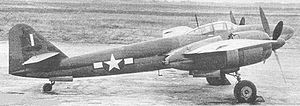Mitsubishi Ki-83 Video - Picture

|
|
Mitsubishi Ki-83
Ki-83

Role: Long-Range Heavy Fighter
Manufacturer: Mitsubishi
Designed by: Tomio Kubo
First flight: 18 November 1944
Status: Prototype
Number built: 4
The Mitsubishi Ki-83 (ã‚83 (航空機)) was a Japanese experimental long-range heavy fighter designed near the end of World War II. It did not reach production status.
Design and development
The Mitsubishi Ki-83 was designed as a long-range heavy fighter. It was designed and built by a team lead by Tomio Kubo, the designer of the highly successful Mitsubishi Ki-46 "Dinah". The design was a response to a 1943 specification for a new heavy fighter with great range. The first of four prototypes flew on 18 November 1944. The machines displayed remarkable maneuverability for aircraft of their size, being able to execute a 671 m (2,200 ft) diameter loop in just 31 seconds at a speed of over 644 km/h (400 mph). The Ki-83 carried a powerful armament of two 30 mm (1.18 in) and two 20 mm cannon in its nose. Plans for the Ki-83 to enter series production within the bomb ravaged Japanese industrial complex were underway when Japan surrendered on 15 August 1945. The Ki-83 was a total surprise to the Americans who, unaware of its existence, had not given it a code name as they had to all other known Japanese World War II aircraft. Following the war, American aeronautical engineers and American Air Force officials evaluated the four prototype machines with great interest. In fact, most of the known photographs of the Ki-83 show it wearing USAAF insignia.
After war, the Ki-83 test flown by the USAAF.
Versions
Ki-83 experimental long-range heavy fighter, four prototypes built.
Ki-95 projected reconnaissance version, none built.
Ki-103 projected development, none built.
Specifications
Data from Japanese Aircraft of the Pacific War
General characteristics
Crew: 2
Length: 12.50 m (41 ft 0â…›)
Wingspan: 15.50 m (50 ft 10¼ in)
Height: 4.60 m (15 ft 1 in)
Wing area: 33.5 m² (361 ft²)
Empty weight: 5,980 kg (13,184 lb)
Loaded weight: 8,795 kg (19,390 lb)
Max takeoff weight: 9,430 kg (20,790 lb)
Powerplant: 2x— Mitsubishi Ha-211ru (Ha-43) 18-cylinder air-cooled radial engines, 1,544 kW (2,070 hp) at 1,000 m (3,284 ft) each
Performance
Maximum speed: 705 km/h (381 kn, 438 mph at 32,180 ft) at 9,000 m (29,500 ft)
Cruise speed: 450 km/h (243 kn, 280 mph)
Range: 1,953 km (1,054 nmi, 1,213 mi)
Service ceiling: 12,600 m (41,500 ft)
Wing loading: 263 kg/m² (53.7 lb/ft²)
Power/mass: 0.35 kW/kg (0.21 hp/lb)
Climb to 10,000 m (32,800 ft): 10 min
Armament
Guns: 2x— 30 mm (1.18 in) and 2x— 20 mm cannon mounted in the fuselage nose
Bibliography
Francillon, Ph.D., René J. Japanese Aircraft of the Pacific War. London, Putnam & Company Ltd., 1970. second edition 1979. ISBN 0-370-30251-6.
Green, William. Warplanes of the Second World War, Volume Three: Fighters. London: Macdonald & Co. (Publishers) Ltd., 1961 (seventh impression 1973). ISBN 0-356-01447-9.
Green, William and Gordon Swanborough. WW2 Aircraft Fact Files: Japanese Army Fighters, Part 1. London: Macdonald & Jane's Publishers Ltd., 1976. ISBN 0-356-08224-5.
Unknown Author(s). Famous Aircraft of the World, first series, no.76: Japanese Army Experimental Fighters (1). Tokyo, Japan: Bunrin-Do Co. Ltd., August 1976.
Mitsubishi Ki-83 Pictures
Living Warbirds: The best warbirds DVD series.
Source: WikiPedia